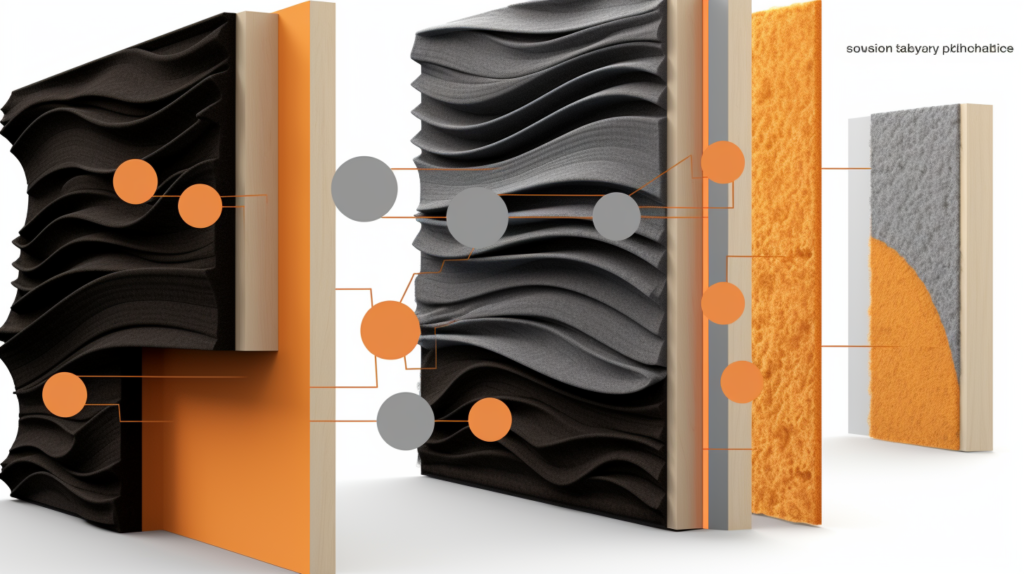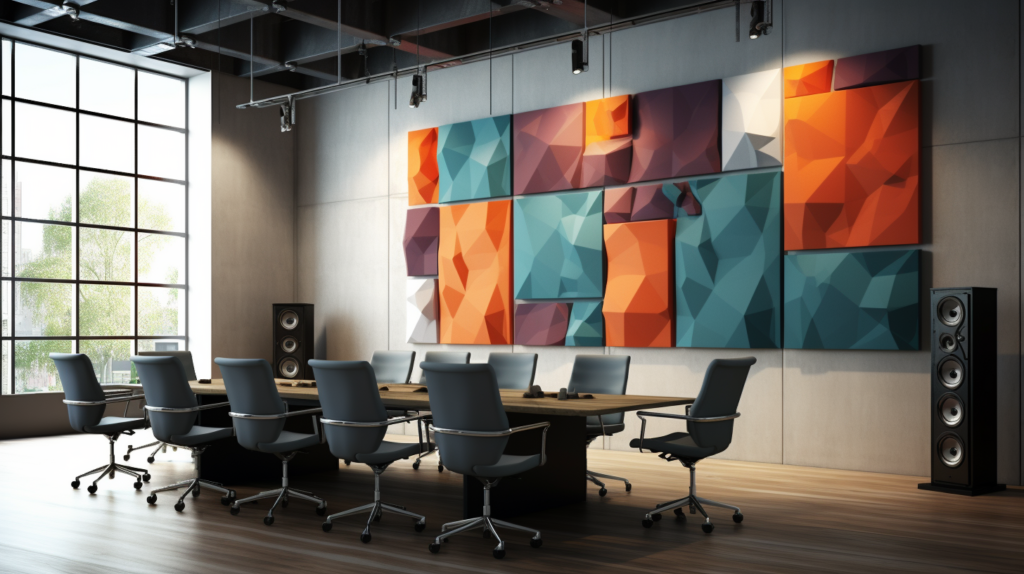Have you ever walked into a room and felt instantly captivated, both by the visual elements and the incredible sound quality?
Imagine if you could combine the best of both worlds — stunning art and impeccable acoustics — into a single, eye-catching feature in your home or office.
Enter acoustic art panels, the revolutionary decor that not only enhances your space visually but also improves its sound quality.
These aren’t your ordinary art pieces; they are meticulously engineered to serve a dual purpose.
With options ranging from fabric-wrapped panels adorned with custom designs to engraved polyester acoustic panels, these unique installations are redefining what it means to have a well-designed space.
So, are you ready to transform your living or working space into an acoustic and aesthetic haven?
Let’s dive in to explore the ins and outs of acoustic art panels.
What Exactly Are Acoustic Art Panels?

At first glance, you might mistake an acoustic art panel for a simple piece of artwork or an intricate wall decoration.
But upon closer inspection, you’ll find that these panels are meticulously engineered to serve a dual purpose.
They are crafted from materials with high acoustic capabilities, such as polyester, foam, or fiberglass, and then adorned with artistic elements.
Read more about what are acoustic panels and how do they work
What Are the Different Types of Acoustic Art Panels?
The versatility of acoustic art panels is one of their most appealing features.
You can select fabric-wrapped panels adorned with your choice of art, or go for polyester acoustic panels that seamlessly blend with your decor.
The fabric used in fabric-wrapped panels is often sublimated with artistic designs, ranging from abstract art to lifelike landscapes, to suit your aesthetic preferences.
Polyester acoustic panels are not just lightweight and eco-friendly; they also offer a high degree of customization. Here are the benefits of polyester acoustic panels.
Apart from being sublimated with designs, they can be engraved with shapes and patterns.
This engraving can create a visual effect similar to that of traditional metal wall art, making these panels both a decorative and functional addition to any space.
Do Acoustic Art Panels Really Improve Sound Quality?

There’s more to acoustic art panels than meets the eye. While they captivate with their visual designs, they also serve a functional role in enhancing a room’s auditory environment.
Whether you opt for fabric-wrapped panels adorned with artwork or engraved polyester acoustic panels that resemble traditional metal wall art, these panels are engineered to absorb sound waves effectively.
So, do they really improve sound quality? Absolutely. These panels are made from materials with proven sound-absorbing capabilities.
Here is an article to help you understand the difference that acoustic panels bring
By reducing the echo and reverberation in a room, they contribute to a clearer and more focused auditory experience.
This makes them ideal for a variety of settings, from home theaters and music studios to corporate meeting rooms and open offices.
The unique aspect of polyester acoustic panels is their ability to be engraved with artistic designs while retaining their sound-absorbing qualities.
This dual functionality makes them a popular choice for those who seek to improve room acoustics without sacrificing aesthetic appeal.
How to DIY Your Acoustic Art Panels?

Selecting Your Core Material
The first step in your DIY journey is choosing your core material.
If you’re leaning towards fabric-wrapped panels, you’ll want to select a material known for its sound-absorbing properties, such as foam or fiberglass.
Deciding on the Artistic Element
For fabric-wrapped panels, you have options for customization.
You can either upload a design or image that you’d like to be printed on the fabric or perform sublimation at home if you have the capability.
This allows you to print your chosen design directly onto the fabric you’ll be using.
For polyester acoustic panels, the customization process is a bit different.
In this case, you would work directly with the manufacturer to have your desired design either printed or engraved on the panels.
These come as finished products, so no assembly is required on your part.
Assembling Your Acoustic Art Panels
The assembly step applies mainly to fabric-wrapped acoustic panels.
After receiving your custom fabric or completing your sublimation, it’s time to wrap this around your chosen core material.
Secure the fabric onto the acoustic core, making sure it’s stretched tight and even. Some people also choose to add a frame at this stage for extra structural integrity.
Once assembled, your next step is to mount the panel securely to your wall.
Check out these guides to help you in your DIY route:
What Are the Advantages and Disadvantages of Using Acoustic Art Panels?

The Advantages
Acoustic art panels are not just a feast for the eyes; they are also a boon for the ears. Their ability to absorb sound significantly improves the acoustic quality of a room.
This is particularly advantageous in spaces where clarity of sound is crucial, such as home theaters, studios, and office meeting rooms.
Another advantage is the aesthetic flexibility they offer.
Fabric-wrapped panels can be customized with any design or artwork, while polyester acoustic panels can be engraved or printed with designs in collaboration with the manufacturer.
This means you can have wall panels that not only improve room acoustics but also enhance the visual appeal of the space.
Wondering on how and where to install your acoustic panels? Read on for more:
The Disadvantages
While acoustic art panels offer numerous benefits, there are also some drawbacks to consider. One of the main disadvantages is cost. Acoustic panels are expensive and here is how much does acoustic panels cost
Custom designs and high-quality materials can make these panels a significant investment.
They also don’t offer soundproofing capabilities; they improve the sound within a room but won’t block sounds from entering or leaving the space.
Conclusion
In closing, acoustic art panels offer an unparalleled blend of visual appeal and acoustic quality.
Whether you opt for fabric-wrapped or engraved polyester panels, you’re making a wise investment in both the look and sound of your space.
While they do come with some drawbacks like cost, the benefits often outweigh the disadvantages.
For those inclined to DIY, customization options abound, allowing for a truly personalized experience. Acoustic art panels aren’t just art; they’re a functional upgrade to any space.
While you are at it, here is top 10 acoustic panels that we recommend. You will find some good acoustic panels that are art pieces as well
Frequently Asked Questions (FAQs): Common Questions About Acoustic Art Panels
How Do I Choose the Right Acoustic Art Panel for My Space?
The first step is to assess the acoustic needs of your room. Smaller rooms may require fewer panels, while larger spaces may need more for effective sound absorption. Read on for how many acoustic panels you really need for your space
The next step is to consider the visual elements. Do you want a fabric-wrapped panel with a custom image or a polyester acoustic panel engraved with artistic designs? Here is an article on how to decorate your acoustic panels
Your choice will depend on your aesthetic preference and the existing decor of your space.
How Do I Maintain My Acoustic Art Panels?
Maintenance will largely depend on the type of panel you choose. Fabric-wrapped panels may require occasional vacuuming or spot-cleaning.
Polyester acoustic panels, on the other hand, are generally low-maintenance and can be dusted or lightly vacuumed to keep them looking their best.
To understand more, here is an article on cleaning and maintaining your acoustic panels
Can You Paint Your Acoustic Art Panels?
A common question that arises is whether these visually appealing panels can be painted over.
While the idea might be tempting, especially for those who love to change their decor frequently, the answer is generally no.
Painting over the panels can compromise their acoustic capabilities.
When you apply paint to an acoustic panel, you risk creating a layer that could impede the panel’s ability to absorb sound effectively.
This is especially true for oil-based paints, which can form a seal over the material. Even water-based paints could affect the acoustic performance to some extent.
Therefore, if you wish to change the look of your panels, it’s better to opt for other customization options like fabric wrapping or engraving on polyester acoustic panels.
To understand more, here is an article on can you paint your acoustic panels and alternatives that you can do to not paint.
